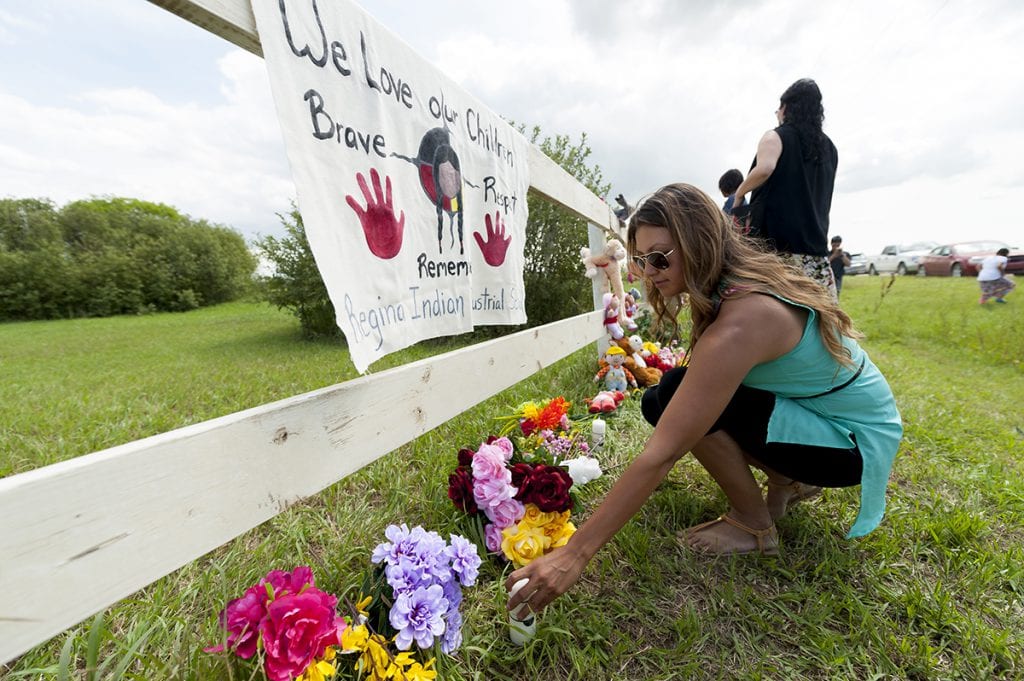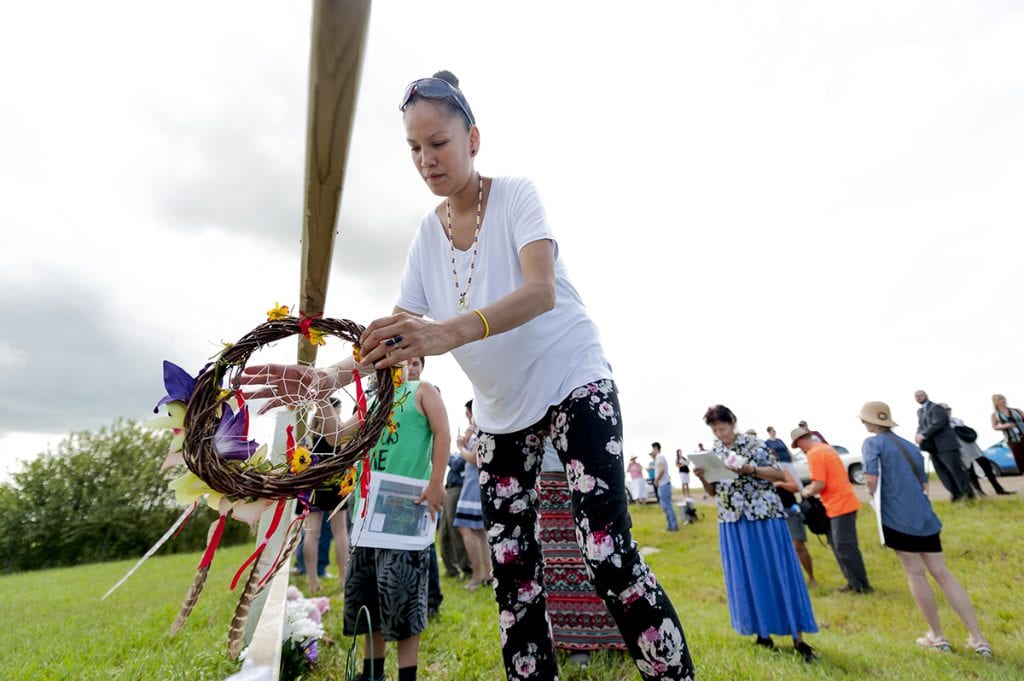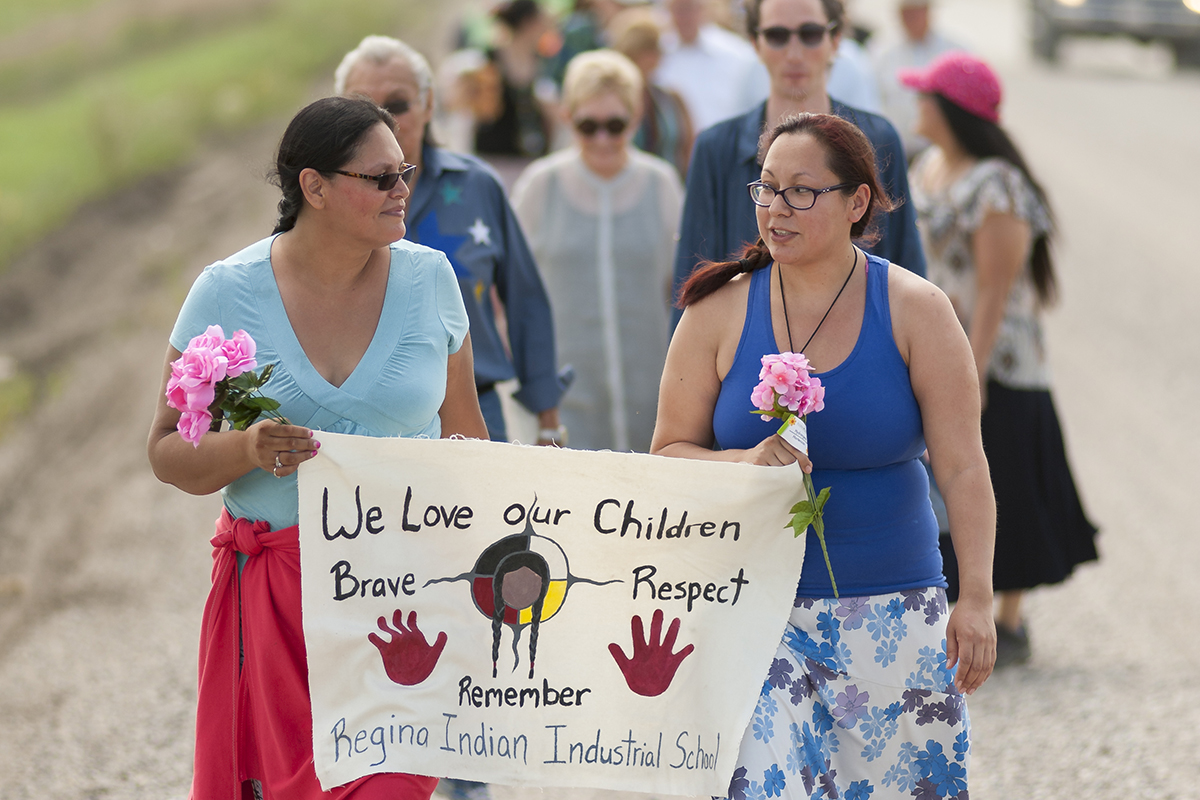EDITOR’S NOTE: This story is from our archives and first appeared in Broadview’s November 2016 issue with the title “Neglected no more.”
On a bright and breezy July afternoon, about 100 people walk along Pinkie Road, a dusty thoroughfare on the western edge of Regina. Some carry signs that read, “We love our children.” Many hold stuffed animals.
You may unsubscribe from any of our newsletters at any time.
The group stops at a patch of land enclosed by a faded white fence. Tall grasses surround the 640-square-metre area, black-eyed Susans grow wildly to the south, a yellow canola field shines brightly to the east and hay bales dot a farmer’s field in the near distance.
Aside from one small headstone, there’s no indication that the earth here holds the remains of an estimated 35 to 40 children who attended the Presbyterian-run Regina Indian Industrial School (RIIS) between 1891 and 1910 and likely died from tuberculosis. The lone headstone, in fact, marks the graves of three non-Indigenous people: children of the school’s first principal.
More on Broadview:
- Reconciliation process: What can Canada learn from Australia?
- This former residential school is now a centre for reconciliation
- These First Nations are taking safe drinking water into their own hands
The walkers — Indigenous and non-Indigenous — tie flowers and dream catchers to the fence and replace the weather-beaten teddy bears left here during last year’s commemorative walk with new ones. Then they spread blankets out on the grass to the north of the cemetery and begin to pray and feast — a ritual in Indigenous cultures to commemorate loved ones who’ve passed.
One of the walkers is Janine Windolph, an Indigenous filmmaker who is also the president of the RIIS Commemorative Association. Two winters ago, when she first went looking for the graveyard for a film project, she nearly missed it — more than a metre of snow covered the site. “I got a real heavy sense of loneliness,” she says.
Although the cemetery site is listed on provincial land titles, few in Regina knew about it. Older people might remember the former school building, located about a kilometre away. When the school closed, the building became the city jail, then a boy’s detention house in 1919. In 1948, the building burned down, and a centre for young offenders — still in existence today — replaced it in 1955.
But the cemetery, and the children buried here, were utterly forgotten and neglected — an affront to Indigenous spirituality and culture. “We honour our ancestors,” says Windolph, who learned Indigenous funeral traditions from her Cree grandmother. “We have feasts just outside the grave. We come and clean it every year. We pray, we tell stories, we remember. And we also take the time to let it be, because that’s part of the process.”
While the cemetery’s abandonment is considered to be a symptom of the dehumanization of Indigenous people by white settlers, some have come to see it as an opportunity for reconciliation.
Four years ago, a small group of non-Indigenous people — members from the United and Presbyterian churches, a professor emeritus from the University of Regina and a member of a municipal heritage committee — began researching the history of the school. The group members studied poorly kept records and collected the names of about 500 children from 45 First Nations who had attended RIIS. They also uncovered the names of 12 students who might be buried at the cemetery and then disseminated the list to various Indigenous people who could confirm the identities of the children. An engineering firm heard about their work and volunteered in 2012 and 2014 to survey the land. It found signs of 38 potential burials, including at least six outside the fence.
This fall, the efforts of the research group, now known as the RIIS Commemorative Association, culminated in victory. In late September, after an initial lack of response from the municipality and thanks, in part, to growing public awareness, Regina’s city council voted to designate the cemetery a municipal heritage site. For the children buried at this site and the descendants of their surviving relatives, the era of abandonment, neglect and collective amnesia is over.
Rev. Bill Wall is a retired United Church minister living in Regina and a member of the RIIS Commemorative Association — a group that’s dedicated to raising awareness about the cemetery and ensuring its protection.
“When I learned about this particular situation,” he says, “I thought, ‘Here’s something in my own backyard.’ The Truth and Reconciliation Commission has spelled out very clearly that reconciliation is not an Indigenous issue. It’s an issue for all Canadians.”
When Wall speaks to crowds, he introduces himself as a recovering racist. Wall was born in Nova Scotia, where racism toward black Canadians was the norm. “Everybody knew that white people were superior,” he says ironically. “So, my racism with regard to Indigenous people just felt normal.”
Wall was ordained in Winnipeg in 1966, and served churches in Manitoba and Saskatchewan before working as executive secretary of the United Church’s Saskatchewan Conference in Regina. He describes an awakening 30 years ago at the 1986 General Council in Sudbury, Ont., that compelled him to begin examining his racist beliefs. The church officially apologized that year for not honouring the spirituality and heritage of Indigenous members of the United Church. The apology was delivered in a teepee. Afterward, people of all cultural backgrounds participated in a round dance. They hugged, laughed and wept. Wall stares out the window of the restaurant we’re sitting in and wipes tears from his cheeks as he relives the experience.

“I think people are resistant if they haven’t had exposure to good information and positive contacts with Indigenous people,” he says. “I’ve had exposure for 30 years to more and more information, and I’ve had opportunity for good, positive contact. So, eventually that breaks down the stereotypes.”
Wall was part of the original working group of non-Indigenous people that researched the history of RIIS and the cemetery.
One of the documents they found was a letter, dated 1921, written by the Saskatchewan branch of the Presbyterian Women’s Missionary Society to the Commissioner of Indian Affairs. It asks the commissioner to see that the cemetery is “put in good order” to ensure that the memory of the children be “kept sacred.” The letter goes on to say that since the school closed, the cemetery has suffered from “desecration and neglect.” It references wooden crosses that, at one time, marked the graves of some “thirty-five to forty of our little Indian children” and cattle had “trampled all over the little mounds flattening them out.” It states that the school’s second principal and his wife took a “great deal . . . of pride in teaching and assisting the children to care for and hold sacred the graves of their little playmates.”
The following year, the cemetery was surveyed and a new fence was built around it. But that’s the last record of any attention paid to the site.
Two years ago, the research group contacted 40 of the First Nations from which RIIS students hailed (only 40 of the original 45 First Nations are still in existence) and invited their leaders to attend a gathering at the cemetery.
In June 2014, about 70 people, including chiefs and band councillors, commemorated the site through prayer, dance and traditional drumming. That afternoon, at St. James United in Regina, the research group passed the reins of protecting and commemorating the cemetery to the Indigenous leaders, offering their continued support. The RIIS Commemorative Association was formed less than a year later, with Janine Windolph as its president.
Windolph first became involved when she and her film partner, Trudy Stewart, were approached to make a documentary about the cemetery. RIIS from Amnesia includes interviews with descendants of the students of the school, church members, elders and historians. Since its world premiere in May 2015, the documentary has screened at Indigenous film festivals in San Francisco, Chicago and New Zealand.
“It was very obvious to us that there had been a sense of amnesia around the school and cemetery,” says Stewart in the opening narration of the documentary. “Rising up from this amnesia has been difficult given what little we’re left with.”
The goal of the Commemorative Association, and the research group that preceded it, has always been to secure municipal and provincial heritage designation for the cemetery. In 2014, a city’s planning department report recommended that a bylaw be established to ensure that the cemetery be maintained by the landowners (two businesspeople from Markham, Ont.). This included mowing the grass several times a year. But the report also discouraged the city council from designating the site a heritage property without more information about the burial area and its value to First Nations and Métis communities.

The group of concerned citizens persevered. They further consulted with Indigenous communities and encouraged them to send letters of support for heritage designation to the city. Many did. At the end of September, after raising awareness about the cemetery and working closely with the city’s planning commission, the group successfully convinced city council to vote unanimously in favour of a motion to designate the cemetery a municipal heritage site. Such designation ensures the site will be commemorated and protected. No one — not even the landowners, who supported the application for heritage designation — will be able to significantly alter the graveyard without permission. The city also agreed to a buffer zone around the cemetery, which will allow for parking and a space for ceremonial gatherings.
“This is the very least we can do at a very difficult time in our history,” Mayor Michael Fougere is quoted by Global News as saying to explain his decision to vote in favour of designation. He also said that protecting the site supports city council’s commitment, made earlier this year, to act on the Truth and Reconciliation Commission (TRC)’s calls to action.
In its recommendations, the TRC called on the federal government to work with churches, Indigenous communities and former residential school students to establish and maintain an online registry of residential school cemeteries. It also called on all levels of government and other invested parties “to develop and implement strategies and procedures for the ongoing identification, documentation, maintenance, commemoration, and protection of residential school cemeteries.”
The RIIS Commemorative Association is now working toward obtaining provincial heritage designation. This would give the cemetery a higher profile and wider recognition. It would also require that anyone wishing to significantly alter the site apply for approval from the province, in addition to the city.
***
Evie Ruddy (they/them) is a freelance journalist living on Treaty 4 lands.
We hope you found this Broadview article engaging.
Our team is working hard to bring you more independent, award-winning journalism. But Broadview is a nonprofit and these are tough times for magazines. Please consider supporting our work. There are a number of ways to do so:
- Subscribe to our magazine and you’ll receive intelligent, timely stories and perspectives delivered to your home 8 times a year.
- Donate to our Friends Fund.
- Give the gift of Broadview to someone special in your life and make a difference!
Thank you for being such wonderful readers.
Jocelyn Bell
Editor/Publisher














